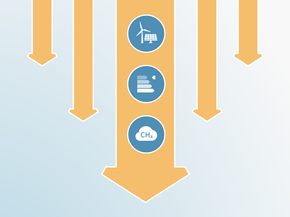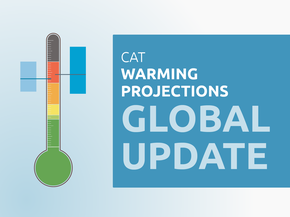Current Policy Projections
Economy-wide
Historical emissions, excluding LULUCF, have increased by 63% from approximately 52 MtCO2e in 1990 to 85 MtCO2e in 2012.[1]
Under currently implemented policies, GHG emissions will increase to 129–139 MtCO2e, excl. LULUCF, by 2030 (149–169% above 1990 levels). These projections take into account policies implemented according to the Third National Communication (Ministerio del Ambiente del Perú, 2016). The minimum range of the current policies projections shows the full mitigation potential of these policies. The maximum range of the current policies projections is equal to the BAU scenario as it is uncertain if the full mitigation potential of those policies would be realised in 2030. However, even under the full mitigation potential of currently implemented policies, Peru will not achieve its NDC targets.
The new Peruvian government, which assumed office after the ratification of the Paris Agreement, has reaffirmed the country’s commitment to the Agreement and is currently developing a new framework law on climate change which foresees the creation of a multi-sectoral commission to regularly update Peru’s NDC (Congreso de la República del Perú, 2017; Radio Nacional del Perú, 2017).
Peru has adopted several policies and planned projects to lower its GHG emissions. The National Strategy on Climate Change establishes 11 strategic national priorities to reduce the adverse impacts of climate change the country faces, including management of ecosystems, mitigation, adaptation and scientific research. The aim of the strategy is to identify potential vulnerabilities where adaptation projects should be implemented, and to define the guidelines for action on mitigation through energy efficiency and renewable energy programmes.
The most relevant sector specific policies are summarised below.
[1] Emissions (including and excluding LULUCF) in 2010 reported in the Third National Communication differ from the levels in the NDC as the National GHG Inventory was only updated after the submission of the INDC.
Energy supply
The policy for ‘promotion of investment for the generation of electricity from renewable energies’ builds on the National Strategy on Climate Change and prioritises renewable energy generation as a matter of national interest and public necessity. It mandates the setting of renewable energy targets as a share of electricity consumption in five-year intervals ‘up to 5%’. Since 2009, four renewable energy auctions have contributed towards achieving this target (El Comercio, 2017).
Peru also has a law to promote an efficient use of energy. Law no. 27345 mandates the Ministry of Energy and Mines to carry out activities aimed at encouraging a culture of improving energy efficiency, in coordination with other public institutions and the private sector. It also defines sectoral programmes for the efficient use of energy.
In addition, the Universal Access Plan 2022 subsidises the installation of improved cook stoves in rural areas.
The law to promote a market for biofuels (Law no. 28054) establishes the general framework to promote the development of biofuels with the aim of diversifying the fuel market. However, the current fuel mix quotas (5% for biodiesel and 7.8% for ethanol) are only considered in the BAU scenario (Government of Peru, 2015a).
Transport
In the transport sector, Peru has already implemented the construction of the Lima Metro Network and the COFIGAS Programme which supports the conversion of vehicles to run on natural gas. In addition, the Scrappage Programme for Public Transport Vehicles is in place - which seeks to replace old buses by more efficient vehicles.
Buildings
In 2015, Peru approved a Sustainable Construction Code to improve technical criteria for the design and construction of public and private buildings (Supreme Decree no. 015-2015-VIVIENDA). More recently, energy efficiency labels for household appliances have been introduced (Supreme Decree no. 009-2017-EM).
Forestry
Peru hosts about 740,000 square kilometres of forests, including the largest area of the Amazon rainforest after Brazil (World Bank, 2015). However, the Amazon is poised to become one of the 11 regions in the world to have more deforestation and forest degradation in 2030 than anywhere else (WWF, 2015), and Peru’s contribution is not insignificant. Deforestation remains a significant problem, particularly in the Andean-Amazon countries like Peru – due to expansion of palm oil, agriculture, illegal logging and informal mining (Swenson et al., 2011; WWF International, 2015).
Peru’s forest law (Law no. no. 29763) and the National Strategy on Protected Areas aim to reduce deforestation through sustainable forest management and improved management of protected areas, respectively. Both policies are included in the current policies projections.
Under current policies projections for the LULUCF sector, emissions from Peruvian deforestation are projected to soar by 81–83% between 2012 and 2030, a growth rate not seen before in Peru’s history. We note that this estimate is significantly higher than previous estimates by CIFOR (CIFOR, 2014). This appears to be at odds with Peru’s refined Copenhagen pledge of reducing LULUCF emissions to zero by 2021. As world LULUCF emissions would need to decrease towards 2030 to fall in the Paris Agreement emissions pathway, Peru needs to address—and prevent—this significant projected increase.
Finally, Peru has further policies in the forestry sector such as the National Forestry and Climate Change Strategy, the law and an executive decree aimed at compensation for services to Ecosystems (Law No. 30215) and the commercialisation of fees by ecosystem conservation (Executive Decree no. 26-2014-SERNANP). However, the emission reduction impact of these policies is unknown.
Further analysis
Latest publications
Stay informed
Subscribe to our newsletter




